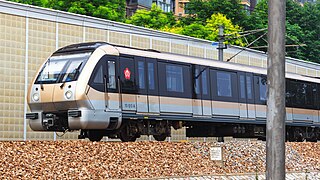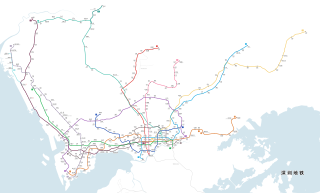 W
WThe Algiers Metro is a rapid transit system that serves Algiers, the capital of Algeria. Originally designed in the 1970s, it opened in 2011 after decades of delays due to financial difficulties and security issues. The Algiers Metro was the second metro system to open in Africa, after the Cairo Metro.
 W
WThe Ardwick train depot is a passenger multiple unit maintenance depot in Ardwick, Greater Manchester. The depot was opened in 2006 for the servicing of Siemens-built Class 185 DMUs, which are used on the TransPennine Express franchise. It was electrified in 2012–13 to allow the servicing of Siemens Class 350/4 EMUs.
 W
WThe Beijing–Tianjin intercity railway is a Chinese high-speed railway that runs 117 km line between Beijing and Tianjin. Designed for passenger traffic only, the Chinese government built the line to accommodate trains traveling at a maximum speed of 350 km/h (217 mph), and currently carries CRH high-speed trains running speeds up to 350 km/h (217 mph) since August 2018.
 W
WThe Dammam–Riyadh line is a passenger railway line in Saudi Arabia, linking the Eastern Province's capital city of Dammam with the Saudi capital Riyadh. The 449 km line has four stations. It is operated by the Saudi Railways Organization (SRO).
 W
WThe Delhi Metro is a mass rapid transit (MRT) system serving Delhi and its satellite cities of Ghaziabad, Faridabad, Gurugram, Noida, Bahadurgarh and Ballabhgarh, in the National Capital Region of India. It is by far the largest and busiest metro rail system in India, and the second oldest after the Kolkata Metro. The network consists of 10 colour-coded lines serving 253 stations in Delhi with a total length of 348 kilometres (216 mi) and has a full reach of 285 stations with a total length of 389 kilometres (242 mi) when including the Gurugram Metro and Noida Metro. The system has a mix of underground, at-grade, and elevated stations using both broad-gauge and standard-gauge. Delhi Metro operates over 2,700 trips daily, starting at around 05:00 and ending at 23:30.
 W
WLine 2 is an east-west line in the Shanghai Metro network. With a length of nearly 64 km, it is the second longest line in the metro system after Line 11. Line 2 runs from East Xujing in the west to Pudong International Airport in the east, passing Hongqiao Airport, the Huangpu river, and the Lujiazui Financial District in Pudong. With a daily ridership of almost 1.5 million, it is the Shanghai Metro's busiest metro line. The eastern portion of the line, from Guanglan Road to Pudong International Airport, was once operated almost independently from the main segment until April 18, 2019 while through service between these two started the next day. The line is colored light green on system maps.
 W
WLine 8 of the Beijing Subway is a rapid transit line in Beijing. It sits on the central axis of Beijing. Line 8's color is green.
 W
WLine 10 of the Beijing Subway is the second loop line in Beijing's rapid transit network as well as the longest and most widely used line. The line is 57.1 km (35.5 mi) in length and runs entirely underground through Haidian, Chaoyang and Fengtai Districts, either directly underneath or just beyond the 3rd Ring Road. The Line 10 loop is situated between two and six kilometers outside the Line 2 loop, which circumnavigates Beijing's old Inner City. Every subway line through the city centre intersects with Line 10, which has 24 transfer stations along route, and 45 stations in all. Line 10's color is Capri.
 W
WThe Nanjing Metro is a rapid transit system serving the urban and suburban districts of Nanjing, the capital city of Jiangsu Province in the People's Republic of China.
 W
WLine 1 of the Nanjing Metro is a north-south line and the first operating metro line in the Nanjing Metro system, inaugurated on September 3, 2005. After the opening of the 25.08 km (15.58 mi)-long south extension line on May 28, 2010, the total length of Line 1 is now 37.9 km (23.5 mi), running from CPU to Maigaoqiao.
 W
WLine 2 of the Nanjing Metro is a subway line that runs mainly in an east-west direction on the Nanjing Metro network, running from Jingtianlu to Youfangqiao; it entered operation on May 28, 2010. It covers a length of 37.95 km (23.58 mi) with 26 stations. Of the 26 stations, 17 stations are underground, 2 stations are on the surface, and the other 7 station are either above ground or elevated stations.
 W
WLine 10 is an east-west line on the Nanjing Metro system, running from Andemen to Yushanlu. Line 10 opened on July 1, 2014 with 14 stations spanning a total of 21.6 km (13.4 mi).
 W
WParis Métro Line 14 is one of the sixteen lines on the Paris Métro. It connects the stations Mairie de Saint-Ouen and Olympiades on a north-west south-east diagonal across the centre of Paris. It was operated completely automatically from the beginning, and the very positive return of that experiment motivated the retrofitting of Line 1 for full automation. Before being put into commercial service Line 14 was known as project Météor, an acronym of MÉTro Est-Ouest Rapide.
 W
WThe Pujiang line of Shanghai Metro is an automated, driverless, rubber-tired Shanghai Metro line in the town of Pujiang in the Shanghainese district of Minhang. It was originally conceived as phase 3 of Shanghai Metro Line 8, but afterwards was constructed as a separate line, connecting with Line 8 at its southern terminus, Shendu Highway. The line opened for passenger trial operations on March 31, 2018. It is the first automated, driverless people mover line in the Shanghai Metro, and has 6 stations with a total length of 6.689 kilometres (4.156 mi). It is colored grey on station maps. The people mover was expected to carry 73,000 passengers a day.
 W
WThe Shenzhen Metro is the rapid transit system for the city of Shenzhen in Guangdong province, China. Extensions opened on 28 October 2020 put the network at 411 kilometres of trackage, operating on 11 lines with 283 stations. Shenzhen Metro is the 4th longest metro system in China and 4th longest in the world as of that date despite having only opened on 28 December 2004. By 2030 the network is planned to comprise 8 express and 24 non-express lines totaling 1,142 kilometers of trackage.
 W
WSiemens Goole is a train factory located in Goole, East Riding of Yorkshire, England. Siemens Mobility scoped several sites in the United Kingdom before settling on Goole with an intent to build the plant if it were successful in gaining orders for new rolling stock. After a June 2018 announcement that Siemens had won the bid to build 94 2024 stock trains for the Piccadilly line of the London Underground, Siemens confirmed it would go ahead with building the factory, though this was then subject to further delays as other rolling stock companies objected to Siemens being given the contract.
 W
WThe York Leeman Road railway depot, in York is a passenger multiple unit depot opened in May 2007 by Siemens. It services TransPennine Express Class 185s.